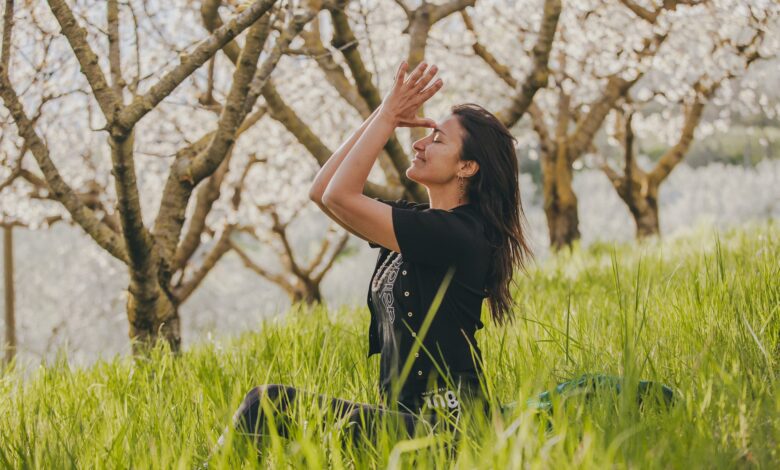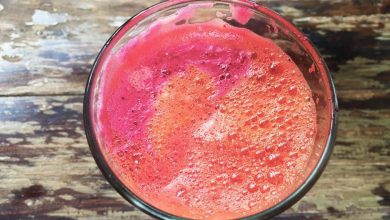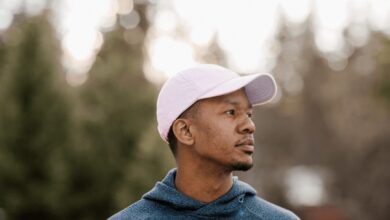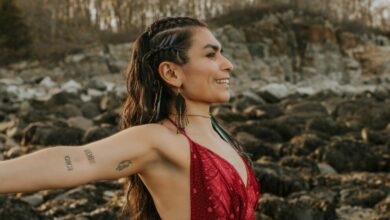Wanderlust Yoga for Leo Season: Stepping Out

[ad_1]
Sections of this article appear in The Yoga Almanac: 52 Practices and Rituals to Stay Grounded Through the Astrological Seasons, March 2020, New Harbinger Publications. Reprinted with permission: New Harbinger Publications, Inc. © 2020 Lisette Cheresson & Andrea Rice.
As August sees summer heating up, we find ourselves strutting our stuff on the beach, around bonfires, and in revelrous city parks. It’s a season for self expression and of confidence—known astrologically as Leo season. Beginning on July 20 or 21 every year, Leo season is characterized by this feeling of “stepping out,” of shaking off the shell of Cancer introspection and nourishment, of shining our face forward toward the mighty sun. As the natural world puts on a show of full bloom, so too do we step into our personal power as the seasons of nurture and nourishment we’ve passed through provide fertile ground for self-expansion.
Leo is symbolized by the Lion, and as such is associated with themes of self-expression, self-confidence, and pride, and rules the heart, upper back, and spine.
It’s apt that Leo, associated with the inner stability necessary to make big moves and confidently go after one’s goals, also rules our backbone. It is only when we have that stable foundation to bend, twist, and adapt, that we are able to fully harness the power of our dream.
Leo’s ruling planet is the sun, which can serve as a sweet metaphor for the Lion, picturing the sun’s rays as a mane of blazing light pushing us to grow. We all have the ability to create life; to nurture and to nourish. Having said that, the sun is actually associated with the divine masculine. Like moon-ruled Cancer last month is associated with the divine feminine, however, this divine masculinity isn’t gendered. It pertains to tendencies of taking action, of pushing forward, that most of us have within.
How Leo Themes Show Up on the Mat
Leo season is prime for the ego pushing front and center. We can turn to the teachings of yoga that encourage us to approach trappings of the ego with careful introspection and a willingness to change. Self-confidence, then, is balanced by vulnerability. Pride is tempered with humility. When it comes to self-expression, we can turn to the yama satya, or truthfulness. Finding our own self-expression is not an invitation to lie or exaggerate. It’s about expressing ourselves within the context of integrity in all we think, do, and say. When we integrate the energetic themes of Leo with the tenets of yogic philosophy, we can assuredly stp into the blazing light of our own personal sun, and embody a Lion’s strength.
Poses for Leo Season
Low or Crescent Lunge (Anjaneyasana)
Image by Yogapedia
Anjaneyasana is named for the mother of the Monkey God Lord Hanuman, Anjani, and the shape of a young child reaching in devotion toward the sun.
Stabilizing the pelvis and targeting the deep core muscles engages the transverse abdominis to facilitate a slight backbend. This helps stimulate the flow of prana in an upward motion along the spinal cord. Crescent Lunge stretches the hip flexors, while engaging the quadriceps and glutes. To avoid overstretching the psoas and “dumping” into the shape, emphasize the rootedness of this posture from the waist down, lifting up and out of the lumbar. Lengthen both sides of the body and create more spaciousness in-between the ribs. Pressing the front foot into the earth helps to stabilize the hips.
Leo is ruled by the Sun, and corresponds to the heart, chest, thoracic spine, and upper back. By strengthening the core and hips, this pose taps into the third (Manipura) chakra, our energetic power center, building confidence to live a life of vulnerability. The natural backbend encourages the opening of the heart (Anahata) chakra to embrace vulnerability from a place of compassion.
Humble or Devotional Warrior (Baddha Virabhadrasana)

Image by YogaPedia
Humble Warrior stretches the shoulders, strengthens the back muscles, mobilizes the thoracic spine, and opens the chest and heart (Anahata) chakra. To avoid straining the knees, take a shorter and wider stance to hone the strength of the legs. Maintain optimal range of motion in the shoulder extensors (Latissimus dorsi, aka “lats”) by bending at the elbows to stabilize the triceps. The shape tones the abdominal muscles and activates the solar plexus (Manipura) chakra, improving digestion. This energy center sustains one’s purpose, humor, and wit, as the ego is said to be forged within these proverbial fires.
Humble Warrior is a bowing to the divine. Any yoga posture that puts the head below the heart can help to fire the heart-brain neurotransmitters. This regulates function of the pineal gland (opening the third eye (Ajna) chakra)—the small endocrine gland that balances hormones and produces melatonin to manage Circadian rhythms, located between the two cerebral hemispheres in the brain.
Upward-Facing Dog (Urdhva Mukha Svanasana)

Image by YogaPedia
The name for this posture is derived from the Sanskrit words ūrdhva, which translates to “up,” and mukha, meaning “face.” In the Mahabharata, there is a story of the Pandava brothers. Upon arrival in heaven, Indra told Yudhisthira that his dog could not accompany him. Citing the dog’s loyalty, Yudhisthira refused to abandon him; the dog was revealed to be Yudhishtira’s godfather and Yudhisthira was rewarded. Upward-Facing Dog is a reminder of devotion to the expression of personal truth.
Leo governs the heart, spine, and upper back. Upward-Facing Dog stretches the trapezius muscles, responsible for movement and stabilization of the shoulder blades. In this slight backbend, the back of the neck (the cervical spine) lengthens to help open the throat and chest. Maintain space between the ears and shoulders by keeping a slight bend in the elbows. Be wary of collapsing into the the lower back, overarching the neck, or dropping the head back, which compresses the cervical spine.
Upward-Facing Dog opens the heart (Anahata) chakra as the shoulderblades protract apart, expanding the back-body and broadening the collarbone. Stimulation of the throat (Vishuddha) chakra allows us to speak this truth with confidence. By drawing focus toward the third eye (Ajna) chakra—associated with the sun, the ruling planet of Leo—we can learn to draw from quiet intuition and wisdom. That is the seat and the expression of our satya.
Reverse Warrior, Exalted Warrior, or Peaceful Warrior (Viparita Virabhadrasana)

Image by YogaPedia
Reverse Warrior is a gesture of opening to all that is coming; an offering of the heart as love is radiated inwardly and outwardly. This posture stretches the chest, shoulders, and upper arms, mobilizes the thoracic spine, lengthens the torso, and strengthens the abdominal wall. The ankles, quadriceps, and glutes engage to stabilize the hips. By bringing a micro-bend into the back knee, weight can be distributed between the front and back leg more evenly.
The gaze, or drishti, is focused toward the fingertips reaching overhead, awakening the third eye (Ajna) chakra. The heart (Anahata) chakra is opened to allow messages to flow from the heart to the pineal gland. The solar plexus (Manipura) chakra is also activated, empowering the practitioner to utilize their innate gifts in conjunction with the desires of the heart.
Wild Thing Pose or Rock Star; “Flipping Your Dog” (Camatkarasana)

Image by YogaPedia
Camatkarasana has been described as “the ecstatic unfolding of the enraptured heart.” It’s an invigorating, enlivening posture that opens our hearts to unfettered joy. It is rare to see a frown or furrowed brow on a yogi actively exploring this pose; even the name, Wild Thing, begets a smile.
The shape mobilizes the thoracic spine by opening the chest and upper back, and stretches the shoulder girdle. Hip flexors lengthen while the quadriceps strengthen, and there is a sense of playfulness as the whole world is turned upside-down. Entering the shape from in-between Downward Dog and Plank Pose helps you flip over with more ease, stability, and safety. By lengthening the neck (cervical spine) and reaching through the crown of the head, the gaze will naturally follow the palm extending overhead.
Wild Thing helps facilitate the heart-to-head transmission of information, activating the pineal gland to rouse the third eye (Ajna) chakra. The pose helps unblock the throat (Vishuddha) chakra, encouraging unabashed self-expression from a place of truth. A tremendous heart-opener, Wild Thing creates spaciousness to make room for joy.
—
 Lisette is a writer, yoga teacher, and content director. She’s a member of the founding leadership team for Yoga Unify, a new yoga non-profit, the Director of Marketing at Mammoth Yoga Festival, and the co-author of The Yoga Almanac. Lisette completed her 200-hour training in Brooklyn and her Reiki attunement in India, and furthered her studies with Leslie Kaminoff of the Breathing Project, Tiffany Cruikshank, and Andrew Holecek. She’s also a Grief Coach and Death Doula, whose work is focused on integrating the tools of mindfulness and asana for grief healing and end-of-life anxiety. A filmmaker in a past life, Lisette has made videos with community leaders such as Dharma Mittra, Eddie Stern, and Eoin Finn. She lives with her husband and animals in the Hudson Valley, NY..
Lisette is a writer, yoga teacher, and content director. She’s a member of the founding leadership team for Yoga Unify, a new yoga non-profit, the Director of Marketing at Mammoth Yoga Festival, and the co-author of The Yoga Almanac. Lisette completed her 200-hour training in Brooklyn and her Reiki attunement in India, and furthered her studies with Leslie Kaminoff of the Breathing Project, Tiffany Cruikshank, and Andrew Holecek. She’s also a Grief Coach and Death Doula, whose work is focused on integrating the tools of mindfulness and asana for grief healing and end-of-life anxiety. A filmmaker in a past life, Lisette has made videos with community leaders such as Dharma Mittra, Eddie Stern, and Eoin Finn. She lives with her husband and animals in the Hudson Valley, NY..

Andrea Rice is a writer and editor covering health and wellness. Her work has appeared in Yoga Journal, The Wanderlust Journal, mindbodygreen, Astrostyle, SONIMA, and New York Yoga+Life. She has also worked as a journalist for The New York Times and INDY Week. As a yoga teacher with a decade of experience, Andrea completed her 200-hour training in New York, NY; and furthered her training with Elena Brower and Alexandria Crow. She has also studied astrology extensively with The AstroTwins, Ophira and Tali Edut. Andrea has offered yoga, meditation, journaling, and creativity workshops in Brooklyn and Manhattan in New York, NY; and has been a presenter at Wanderlust. She lives in Raleigh, NC, with her husband and their cat, where she teaches yoga at Blue Lotus and the North Carolina Museum of Art.
[ad_2]
Source link






